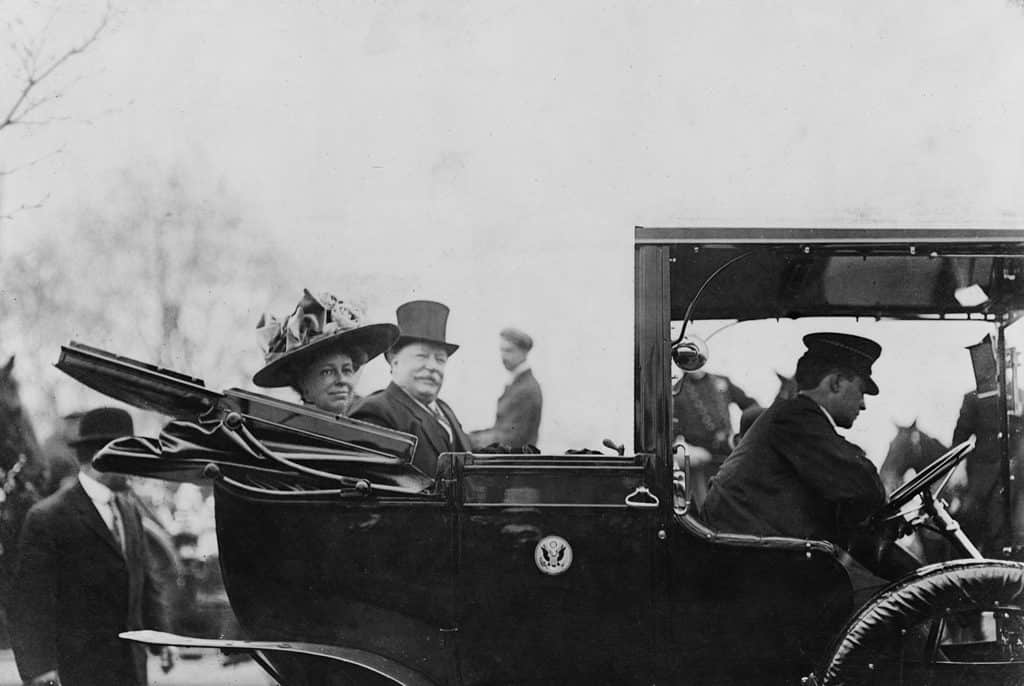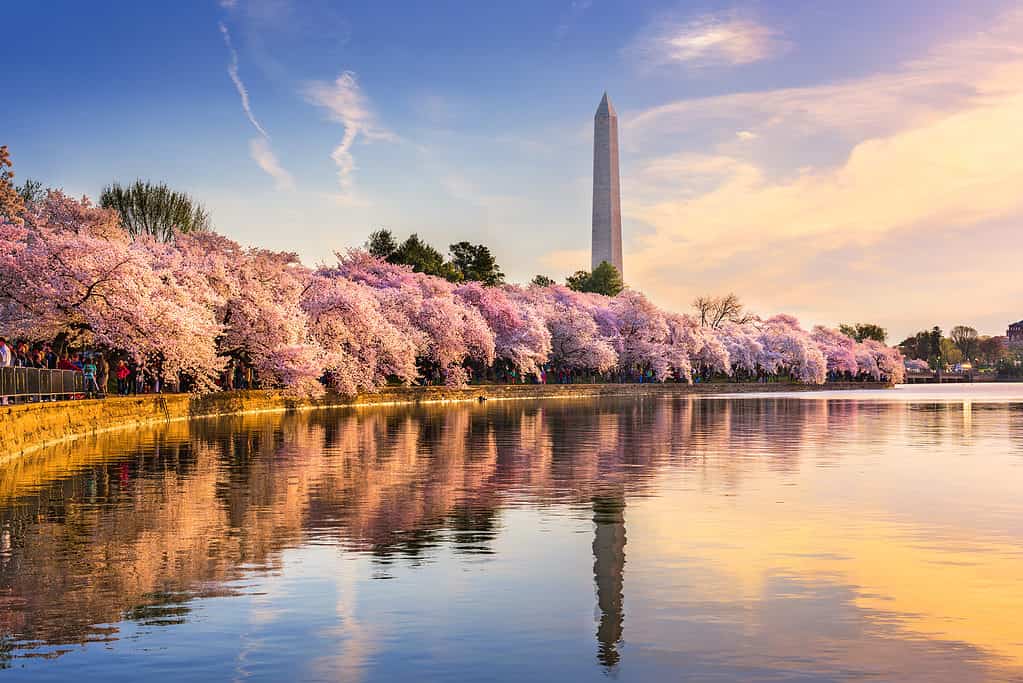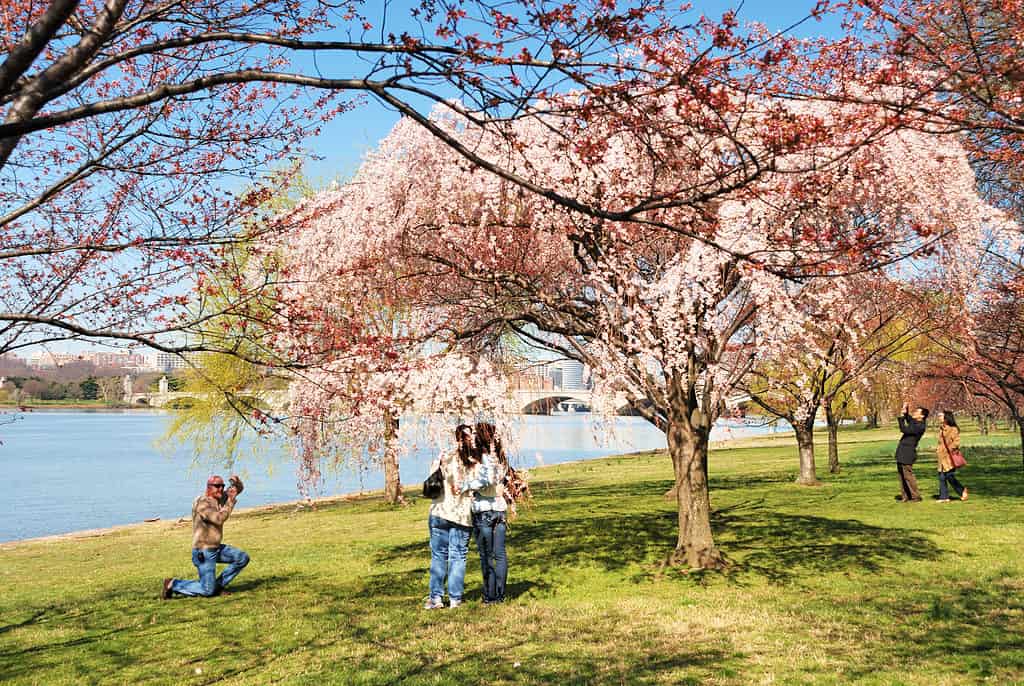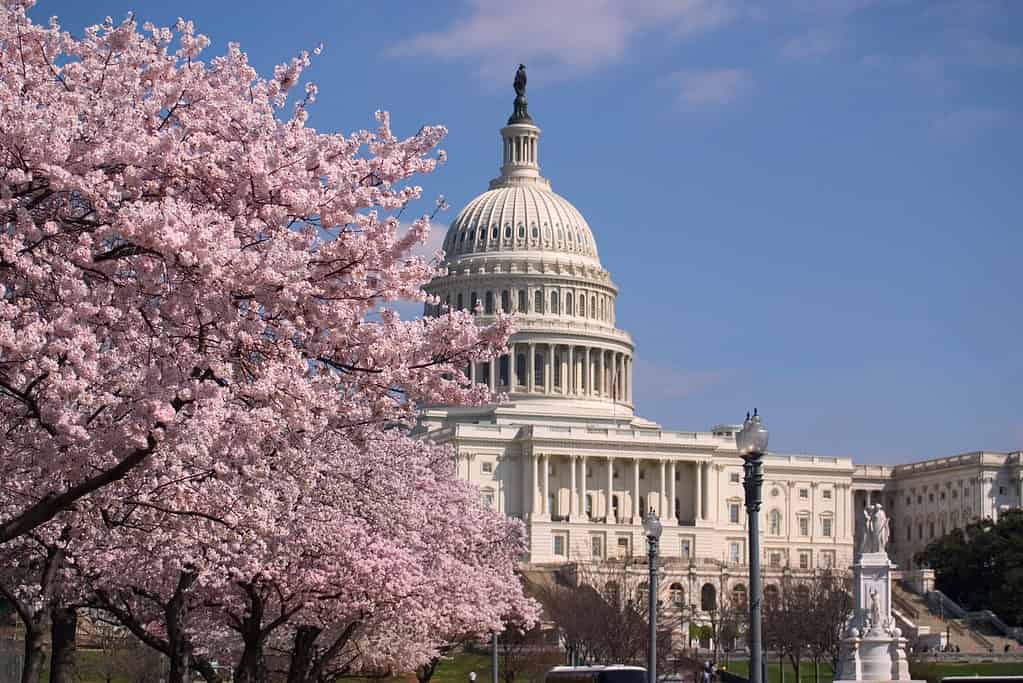The most famous location to view spring cherry blossoms in the United States is undoubtedly in the nation’s capital. The arrival of the cherry blossoms in Washington, D.C., is a harbinger of spring and has been celebrated for generations.
Here is a bit of the history behind these iconic blooms and some valuable information about when and where to best view them.
History of the Washington, D.C., Cherry Blossoms
The story of Washington’s cherry blossoms really begins with First Lady Helen “Nellie” Taft, wife of the 27th U.S. president William Howard Taft. During a visit to Japan, Mrs. Taft observed the Japanese custom of hanami, which literally means “flower viewing.” She watched the Japanese people picnicking, relaxing, and enjoying the blooming flowers of Japan’s native cherry trees. This gave birth to Mrs. Taft’s vision of how Washington, D.C., could also be adorned with these beautiful trees.
Fast-forward to 1912. The mayor of Tokyo, Yukio Ozaki, gave the United States more than 3,000 cherry trees to be planted in Washington, D.C. Although the 16-petal chrysanthemum appears on Japan’s imperial seal, the cherry blossom has long been recognized as the “unofficial” national flower of Japan. This gift from Mayor Ozaki to Washington, D.C., celebrated the friendship between the two cities and nations. (The U.S. gifted Japan flowering dogwood trees in 1915 to reciprocate.)
It was Helen Taft, along with the wife of the Japanese ambassador, who put the first spade in the ground in 1912, where the initial trees would be planted. This site sits just east of where the Martin Luther King Jr. Memorial stands today.
This began a longstanding tradition of U.S. First Ladies and their care for Washington’s cherry trees. Through the years, First Ladies such as Florence Harding, Eleanor Roosevelt, Mamie Eisenhower, Jacqueline Kennedy, “Lady Bird” Johnson, Nancy Reagan, Hillary Clinton, Laura Bush, and Michelle Obama have all had a significant impact on the planting, care, and propagation of the District’s cherry trees.

First Lady Helen Taft, pictured here in a convertible with her husband, President William Howard Taft, was the original visionary for what would become Washington, DC’s iconic cherry trees.
©Everett Collection/Shutterstock.com
Varieties of Washington, D.C., Cherry Trees
While the original gift from Japan included 12 different varieties of cherry trees, one species dominates the landscape of Washington, D.C., today. The Yoshino cherry tree accounts for 70% of the cherry trees currently growing in the District.
There are other varieties, of course, including the Kwanzan cherry tree (Prunus serrulata ‘Kwanzan’), which blooms with pink double blossoms roughly two weeks after the Yoshinos. It is the pinkish-white Yoshino blossoms that are the preeminent blooms in the city’s spring landscape, though.
Yoshino cherry trees are mostly grown as ornamental trees, both in Japan and in the United States. The blooms are soon followed by small black cherries that, while edible, have quite a bitter taste. But, while humans find them distasteful, many birds love them.

The pink and white hues of the Yoshino cherry blossoms dominate the spring landscape of Washington, D.C.
©iStock.com/Chloe Harris
Timing the Blooms
Viewing Washington’s cherry blossoms at their spectacular peak requires a bit of a guessing game each year. Peak bloom is declared when 70% of the Tidal Basin Yoshino trees have fully flowered. The National Park Service (NPS) publishes an annual bloom watch on its official website. It also clearly states, though, that it’s nearly impossible to predict the timing of the blooms more than ten days in advance.
Using the past 100+ years of data, the average peak bloom date for the D.C. cherry blossoms is April 4. That date is far from exact, though. The NPS notes that the trees have reached peak bloom as early as March 15 (1990) and as late as April 18 (1958).
Out of the nearly 4,000 cherry trees in Washington, D.C., there is one individual tree that has become known as the indicator tree. There is no sign or marker to distinguish it from the others. In fact, it looks no different than any of the other cherry trees for much of the year. But, for reasons that aren’t fully understood, this individual tree blooms approximately a week earlier than the rest. So when this tree, which is close to the Jefferson Memorial, blooms, it indicates that the magnificent Washington, D.C., cherry blossoms are just days away from appearing. Fewer than 200 of the original trees gifted to the U.S. in 1912 remain, but the indicator tree is counted among them.

In peak bloom, the cherry blossoms near the Washington Monument are dazzling!
©iStock.com/SeanPavonePhoto
How Long Do the Blooms Last?
When the cherry trees are in peak bloom, the blossoms usually last 4-7 days. If the weather remains cool and calm, the flowers can last longer, sometimes nearly two weeks. The bloom time can also be cut short due to adverse weather. 2017 was a particularly short season, for example. At least half of the blooms that year were lost in a late frost.

A late spring frost can cut the bloom time of cherry blossoms short.
©Pavel Kovaricek/Shutterstock.com
National Cherry Blossom Festival
The National Cherry Blossom Festival is an annual celebration in the District, running from mid-March to mid-April. The city celebrates its world-famous cherry blossoms for nearly a month with a calendar packed with different events such as a parade, fireworks, art shows, concerts, a kite festival, and a 10-mile race.

There are endless photo opportunities each year at the National Cherry Blossom Festival!
©iStock.com/NoDerog
Where to View the Cherry Blossoms
The optimum spot to view the cherry blossoms in Washington, D.C., is the Tidal Basin. The Yoshino cherry trees create a pillowy pinkish-white springtime scene near famous sites such as the Jefferson Memorial and the Martin Luther King, Jr. Memorial. The photo opportunities are seemingly endless through this space and along the shoreline of East Potomac Park. There are also smaller clusters of cherry trees along the National Mall and around the Washington Monument.
There is a downside to all of these sites, though: the crowds. People from all over the world flock to the city to see the cherry blossoms each spring. These are usually the areas with the highest concentration of visitors.
If you want to escape the crowds, there are also cherry trees in lesser-traveled parts of the greater D.C. area, such as the National Arboretum, George Mason Memorial, Dumbarton Oaks in Georgetown, Kenilworth Park & Aquatic Gardens, Stanton Park, Anacostia Park, and Oxon Run Park, which actually has one of the largest concentrations of cherry trees in the city, but is normally far less crowded than the Tidal Basin.

The Martin Luther King, Jr. Memorial in Washington, D.C., is flanked by cherry blossoms each spring.
©iStock.com/Tim Brown
A Few Final Things to Remember
When you are in Washington to view the cherry blossoms, do not pick them! Breaking off a branch or picking a cherry blossom is considered vandalism of federal property. It is punishable with a fine or even arrest in more egregious cases. So, when in D.C., take as many pictures as you can, but don’t take a single blossom or branch off of the trees.
There are many ways to tour Washington’s cherry blossoms. The most popular method is on foot, but there are also opportunities for biking or taking a scenic drive. There are bus tours, water taxis, and even segway tours.
To avoid the busiest times around the Tidal Basin, visit in the morning or evening on a weekday. Middays and weekends are sure to be the most crowded times.
With advanced planning, proper timing, and a little bit of luck, you can see the full glory of Washington, D.C.’s cherry blossoms next spring!

The grounds of the U.S. Capitol are decorated with cherry blooms in the springtime.
©iStock.com/BeeCoolPhoto
The photo featured at the top of this post is © iStock.com/Sean Pavone
Thank you for reading! Have some feedback for us? Contact the AZ Animals editorial team.






